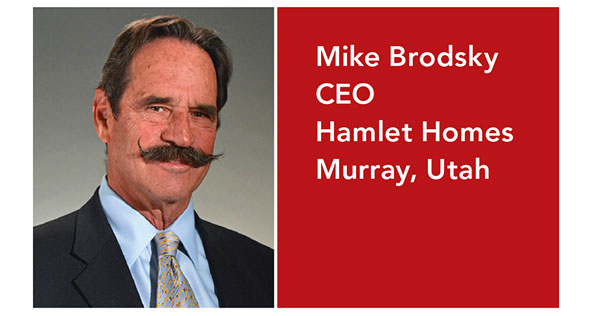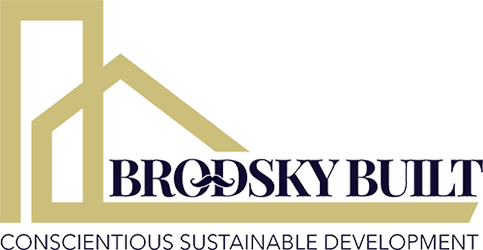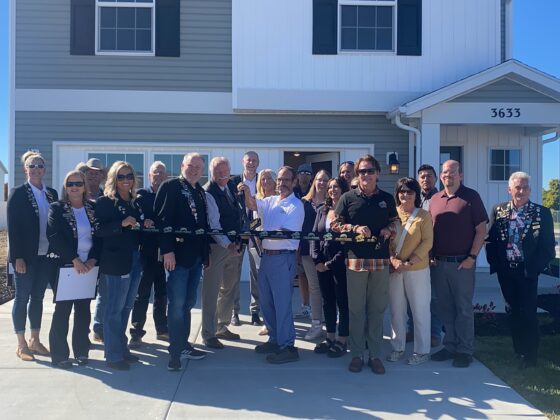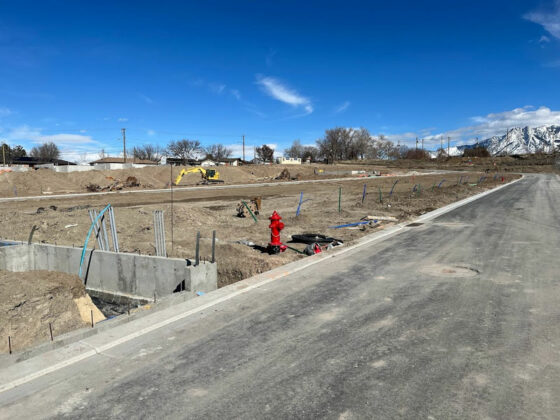 After almost 25 years building more than 3,500 homes
in northern Utah, Mike Brodsky found himself thinking about what every home building company owner eventually has to contemplate: his
exit strategy.
After almost 25 years building more than 3,500 homes
in northern Utah, Mike Brodsky found himself thinking about what every home building company owner eventually has to contemplate: his
exit strategy.
Hamlet Homes, started in 1995 with fellow Ryland Homes veteran John Aldous as president, grew to a steady threshold of 300 closings annually between 1998 and 2008, peaking at $108 million in revenue during 2006.
Then the Great Recession hit hard. The company closed just 16 units in 2011 and Brodsky spent much of the downturn renegotiating with lenders. He survived the slump and was able to pay everyone he owed money to in full. Hamlet recovered to where it now closes about 100 homes per year with 20 employees. But that experience took a toll, and Brodsky started thinking about what was next.
Aldous expressed his desire to retire (although he still works at Hamlet handling product development), so in 2014, Brodsky conducted a national search for a new president and COO, hiring Barry Gittleman in 2016, with the intention of eventually selling the company to Gittleman and three other senior managers, Jon Southern, VP of construction; Phil Mosher, VP of sales; and Elliott Jenkins, VP and CFO. Brodsky shares more details about how he did it and the challenges along the way.
Q: Why did you start the transition process with the national search for a president?
A: At this point, I’m almost 70. I don’t want to retire, but I did want to step down from a 60-hour week. The pressure of the recession had been pretty severe on me. I wanted a bit of a break. I knew I wasn’t ripe to sell the company to a national builder. A national would look for land position, and I didn’t have 100 lots in 2014/15.
I could have shut the company down, but we had a core of really good, competent people and an extremely solid reputation for integrity in this market, so the idea of selling to my employees was very appealing to me.
Q: Was there a next generation that could have taken over?
A: I have two sons. One has no interest in Hamlet. He grew up watching his dad work his butt off. My second son took an unusual route. He graduated from high school and immediately went to Japan. He spent a couple of years learning the language so he could enroll in a Japanese university and earn a business degree. He came back to the U.S. and decided to work for me, but at that point I didn’t think I had enough years left in me to properly train him to take over the company.
Learning a home building company and how to run it effectively isn’t something you can pick up in a year or two. After a couple of years, he decided to go back to Japan and is now working for a Japanese home builder.
Within the core group of my managers, I didn’t have an entrepreneur. That’s why I decided to do the national search. I needed somebody with an entrepreneurial bent who wanted to grow the company and was capable of raising money. The people I have in the company today are excellent operators. They all understand their disciplines well and are highly qualified and talented at what they do. But there wasn’t a profit center manager within that group.
Q: How did the sale of the company proceed?
A: I hired Barry Gittleman, and a year into it we went forward with the buyout. The structure of the buyout is that the three existing managers and Barry formed a partnership to buy Hamlet through an asset purchase agreement. We got an appraisal and valuation of the company and its assets. The buyers didn’t have to put up any cash.
When the transition occurred, any active communities where I was the guarantor and principal owner stayed in my name and the earnings came back to me. Any new business that they started where they were the guarantors and had financed it and provided the equity was theirs. The earnings from their new transactions is what they’re using to pay me out. Two years into this I will receive my first partial payment [in March 2019], and I expect over the next three or four years they will be able to pay me out. During this transition period, I am still their CEO. We entered into an agreement where they assign me 100 percent of their corporate votes and in the role of CEO, theoretically, I have some oversight over what they do. They provide me a salary and some administrative services for my business.
Q: Were they open to having you stay to help with the transition?
A: Sort of. So far it’s been a Cinderella story and there’s a little bit of a scullery maid part to it too that I will get to. The banks were initially reluctant to just lend them money. They were insistent that I co-sign deals. That wasn’t the structure. Frankly, I had two goals when I sold them the company: The first was to get out from under the tens of millions of dollars of debt that I had signed for, and the second was to get paid. The first was more important to me than the second.
Also, the investor group that I had put together over the years wasn’t investing in Hamlet Homes. They were people I have done business with, so they knew me well; they would tell you they are investing in Michael Brodsky, not a company, not a subdivision. They trusted me.
And so with this new management group, [the managers] have the challenge of transitioning over to where it is completely their company. That’s been a little challenging partly because of me. Whether I’ve been with Hamlet Homes or Ryland Homes, I’ve been a profit center manager for 40 years. I describe myself as their CEO here, but I am in name only. If they don’t have the rights and authority to run their own business and make their own decisions, I can’t be effective. I can’t step in. They gave me all of their corporate votes, but I never used them.
There have been some times when we had some serious conflicts. We’ve worked through them with gnashing teeth and screaming at one another, and sometimes with calm negotiations and a little bit of both. But ultimately they purchased the company from me. It’s their company. I can’t run it. They won’t let me run it, nor should I have the right to try to run it.
The biggest challenge in this whole transition for me was handing over the reins, walking away, and not being in charge anymore. It took me more than a year to get to the point where I recognized it’s not my company. At best, I am a lien holder. I disagree with some of the decisions they make. I disagree with some of the operating policies they’ve instituted—some are minor, some are significant—but it’s not my decision anymore, and it’s hard to give that up.
Q: How did you work through that angst?
A: I’ve been part of a Builder 20 Group for 17 or 18 years. That Builder 20 Group has been so valuable to me on hundreds of different levels, and this was one of them. The structure of the buyout came from what one of the other members in that group did with his employees and children who were on the other side of the buyout. But he still went through a very formal and structured program, and I modeled off of what he did.
There were times where I was ready to pull everybody’s hair out, and I either called a couple of the guys in my group as a sounding board or, in one instance, I was ready to blow up the whole deal and it was before one of our Builder 20 meetings. At the meeting, one of the guys talked me off the ledge. I came back from that meeting with a completely different attitude. So it was a mentor group of peers. It was sharing best practices with one another. It was sharing challenges that we had and how we got through them. More than anything, it was this Builder 20 group that made this thing work.
Q: How transparent were you about telling the search candidates about the opportunity for future ownership?
A: I was incredibly transparent. I was searching for a company president who would become part of the management team that would acquire the company. That was part of the search criteria. The initial discussion with Jon, Phil, and Elliott was that I would sell the company to the three of them. I identified one of the three as the potential president of the company, and then I watched his decision-making process. I watched the interaction among them for over a year, and I came to the conclusion that he was not capable of running and growing the company.
In retrospect, it was the right decision. One of the things Barry has done, which is really challenging, is he has the ability to raise equity. He has a pretty significant network of acquaintances, both business and personal, that has given him the ability to raise a couple million dollars of equity over the last two years. The way I structured the company, we’re somewhat leveraged. The company operates on a combination of private equity and institutional financing. He has taken that model I created and continued it pretty effectively.
Q: How did you convince Barry and the other managers to work together as the next owners?
A: I had Jon, Phil, and Elliott as part of the interview process. The three of them individually or collectively, if they had turned [the candidate] down, it was no go because it was as important to me that whoever I hired get along with them. That was critical. They were intimately involved in the interview process.
Q: How many candidates did you interview before deciding on Barry?
A: I did maybe nine or 10 interviews. I actually made an offer to someone I interviewed, but I’m glad I didn’t hire him because days before he was supposed to start here he got an offer from somebody else. I felt it was really important that the other three guys approved whomever it was that I hired. I used an executive recruiter, Bill Carpitella [of Fast Tracking Solutions] who I had known for 20 or 30 years. I did a lot of recruiting at Ryland for the company and the divisions and Bill was one of the recruiters I worked with back then.
Q: What other third parties did you consult for the transition?
A: Getting the right players on the bus was the first thing. I’ve got a law firm in Utah that I’ve done business with for many years and one of their partners helped me assemble all of the documentation. I have an accounting firm I work with on a regular basis. They know me and they knew the company pretty well. They helped me find the business appraiser for the asset purchase agreement. I also relied heavily on Elliott, our CFO. He also is our CPA.
Q: Did other employees know an executive search was underway and did you let your trade partners and suppliers know what was happening?
A: We’re a fairly small company at the time. I always felt running a transparent company was always important, so all of the employees were aware of the general outline for what we were trying to do.
I’m not sure how much info we provided to our subcontractors. We have a subcontractor banquet every year, and I know at the subcontractor banquet I announced that we were hiring Barry to replace John. At another banquet, we discussed an employee buyout. I did a press release a couple of months ago that was sent out to all the people we do business with, including our subcontractors. We’ve made a pretty significant effort to be clear on what we were doing.
Q: What’s next for you?
A: I’m in the process of reinventing myself and the rest of the company. So I retained Hamlet Development, which was always a separate company, and I continue to be the CEO and COO of that company. Hamlet Development still provides Hamlet Homes with finished building lots. The majority of lots they build on come from my development company.
I’m actively looking at other business ventures. For example, I just put a property under contract to build 24 rental townhouses. Over the next couple of years, I am looking forward to building a portfolio of 100 to 150 rental homes, single-family townhouses, and single-family detached homes in small subdivisions. My foreseeable goal with the rental properties is to generate a passive income with an opportunity of developing significant equity in them and at some point in time to sell them. I’m also building a 30,000-square-foot office building to house Hamlet Homes and related companies that will be ready to move into in July or August of this year.
So I’m talking about wanting to slow down. I’m not talking about stopping anything.
Access a PDF of this article, as it appeared in print, in Professional Builder’s May 2019 digital edition




